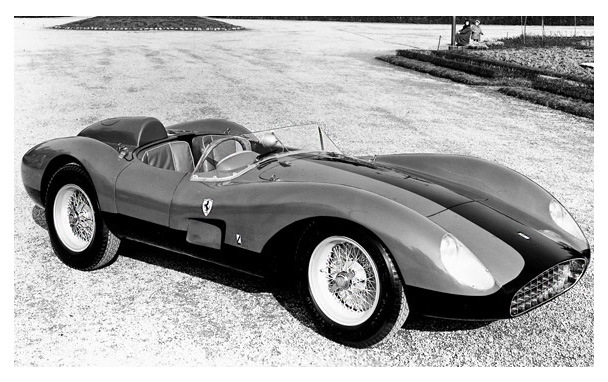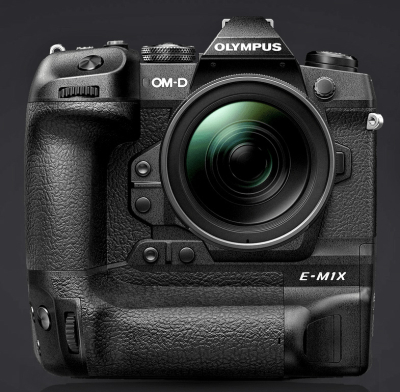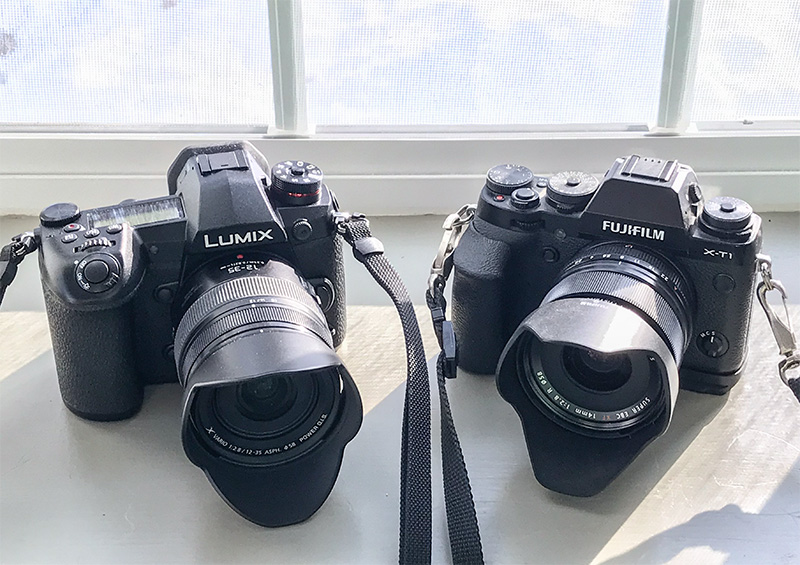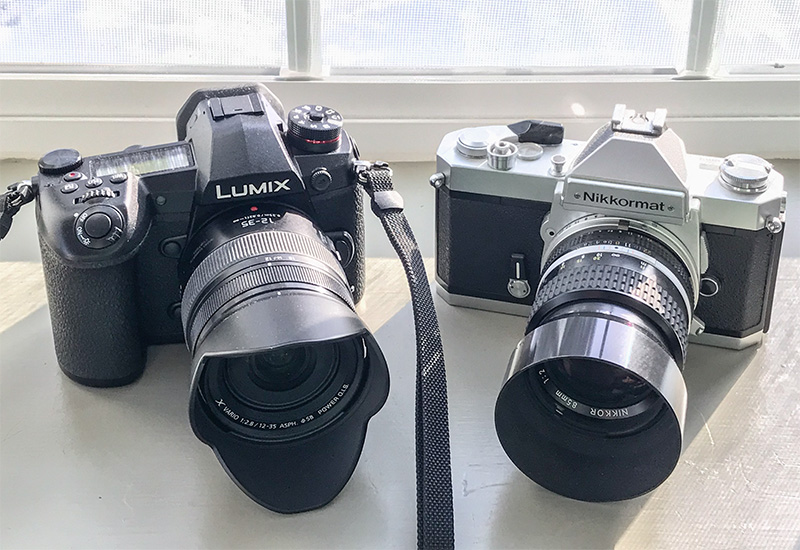Please read the disclaimer before proceeding!
Disclaimer: NOTHING AGAINST Olympus, Olympus fans, Olympus users, anyone who's interested in this camera, anyone who's shopping for it, anyone who likes what it represents, anyone who's interested in its tech, anyone who thinks they might be able to make use of what it offers, anyone who's considering buying one, and, especially, any actual work (pictures or videos) that might be made with one. No hate...for it, you, Olympus or E-mix pics/vids.
If you'll look at the front of the new Olympus you'll see why I've been calling it the "E-mix," pronounced ee-micks, because "M1X" looks so much like "mix." Apropos that, isn't it a great thing that the alphabet contains the otherwise nearly superfluous letter X? What would the camera industry do without it?
Uh-oh, I'm digressing.
Character defect.
Before you read on, though, did you read the disclaimer? I want to make sure everyone read the disclaimer. Otherwise I'll get slammed with all sort of accusatory comments and emails over the weekend, and I'm in much too good a mood for that.
It's true that I'm probably supposed to be getting carried away by all the specs and the launch celebration like everybody else. I guess I resist celebratory launches—I'm like a grouch at the Super Bowl who wanders around muttering about CTE. However, if there was ever a product in our category I'm not in the market for, this would be it. And you should know that.
Okay. So, a question for you: Is it just me, or does this product (behind all the hoopla) maybe make less than perfect sense?
(What'd he say?! Whoops, please re-read that disclaimer again now.)
Don't get me wrong. I use Micro 4/3; I'm on record repeatedly as liking the 20-MP 4/3 sensors; and I'm not a professional so I'm not in the target market for the E-mix. But at first blush there seems to be some kinda cognitive dissonance going on with this new Olympus beastie, except maybe for critter and airshow photographers and others who need a lot of reach. It kinda feels like a supercar with a little motor, like maybe...I don't know, a 4-cylinder Ferrari.
For those of you who might be car-illiterate, or more so than I, Enzo Ferrari, as I understand the story, originally considered himself an engine maker, and his cars were deliberately and specifically 12-cylinder race cars—he originally built road cars to subsidize and homologate the racing program. Enzo's son Dino convinced his father to race V6 and V8 cars in the '50s, but when Ferrari built road cars with smaller-than-12-cylinder engines, starting in 1968, he didn't call them Ferraris at first—he called them Dinos, reserving the fabled "Ferrari" moniker for 12-cylinder automobiles.
Ferrari did make some 4-cylinder engines, originally designed by Aurelio Lampredi for Formula 2. But a Ferrari road car with a 4-banger? Not on your life.
I presume if I got anything too badly wrong in the foregoing paragraphs, reader and car aficionado extraordinaire Jim Hayes will set me back on the right, ah, track.
By the way, I like 4-cylinder engines too, although I'm really a 6-cylinder fanboy. I like V6's and straight 6's best. My dream car, for instance—yes, I know this is quirky—would be a Miata with a transplanted GM LFX V6 engine. Yum.
But I digress.
Again.
Back to the E-mix: I could be wrong. It just seems to me like a Pen-F, E-M5 Mark II, or GX9 is an all-around better housing for a 20-MP 4/3 sensor than a camera that mimics the style and purpose of the biggest pro Canons and Nikons.
Just wondering what you're thinking of Olympus's thinking here.
Remember that disclaimer!
Mike
ADDENDUM:
 Actual 4-cylinder Ferrari—a 1957 500 TRC. But get this...it was a V4.
Actual 4-cylinder Ferrari—a 1957 500 TRC. But get this...it was a V4.
(Thanks to Hugh Crawford. Photo: Ferrari.)
UPDATE Jim Hayes adds: "I dig your analogy Michael! Enzo Ferrari reportedly never had much interest in road cars; just selling them to fund his racing. Big 12-cylinder road cars sold for much higher prices and made more profits, so that made marketing sense. When it came to racing he would build cars for any class he wanted to participate in, so if he needed an engine with fewer cylinders and less displacement, he would do it. They even experimented with 2-cylinder engines.
"While there was never a 4-cylinder road Ferrari, there nearly was one. He commissioned Bizzarini to build a miniature GT based on a 4-cylinder 1- liter engine derived from the current 12-cylinder 3-liter cars. Bertone designed a coupe for it. It never made production at Ferrari but was sold to ASA and eventually surfaced as the ASA 1000GT around 1967.
"It looked like a miniature Ferrari. The car was tiny and the engine, which looked Ferrari-ish, was jewel-like. I've seen a few and they are the size of a small Fiat of the era. Only about 40 were made and they are collectors items."
Original contents copyright 2019 by Michael C. Johnston and/or the bylined author. All Rights Reserved. Links in this post may be to our affiliates; sales through affiliate links may benefit this site.
(To see all the comments, click on the "Comments" link below.)
Featured Comments from:
psu: "FWIW Thom Hogan is using the same analogy. 😃 🚗 "
Mike replies: I swear I did not read or see anyone else's thoughts about the camera before composing my own. But..."great minds think alike"?
Stephen Scharf (partial comment): "I think the E-M1X was designed exactly the way it should be to do the job it was designed to do. As a very long-time Canon 1D-series user, that is very clear. The E-M5 MkII, Pen E or G9 camera frames and lens mounts are not torsionally stiff and strong enough for the types of long (and relatively heavy) lenses that would need to be mounted on this camera and maintain critical optical tolerances, let alone providing the requisite durability and reliability. Pros don't care a whole lot about all the newest specs, they care about toughness and durability. And shutter life."
Chris C: "It's bigger and heavier than the medium format Fuji GFX 50R!"
Ken Blumberg: "I've been a dedicated OM-D owner for the past seven years (E-M1 Mark II and E-M5 Mark II currently). I enjoyed your digressions and especially like your Ferrari analogy. What brought me to switch from APC to Micro 4/3 was the form factor. I think the E-mix is a miscalculation. I'm looking forward to the E-M1 Mark III."
kirk Tuck: "So. Deep breath. Not every camera is designed and purposed for walking around Downtown Austin with the instrument draped over my shoulder, sporting a nice, smallish lens and being unobtrusive. Some photographers, especially those who photograph all kinds of sports (think Olympics) wildlife and other pursuits that require long, fast lenses, spend hours holding up said long lenses in their hangs, anchored by a camera body. If you have ever done this kind of work you have probably found out that a larger camera with more gripping space helps to hold the entire package more comfortably. In the same pursuits having a robust body is also a good thing. As is a fast frame rate. In the "old days" when everything revolved around print photographers convinced themselves that they needed big (think V12) sensors. Now some prefer smaller sensors in order to reduce the size and weight of those long lenses while still delivering ample image quality. They are helped in this pursuit by the current target media: electronic screens. About 60–70% of Internet content goes to cellular phone screens.... This means that the final results from a smaller sensor camera will seem identical to big sensor cameras when viewed in the medium of choice for the majority of audiences. But the small sensor camera users still want the robustness of the larger body as well as the comfort afforded by the larger contact area for their hands.
"And since I keep saying hands I would also mention that these working photographers (Olympus' target market for a camera like this) will appreciate image stabilization that is head and shoulders above competitors' offering.
"So, what we have here is a well-considered specialists tool that can also be a 'halo' product for Olympus. It was never intended to be an 'all-around' much as a Ferrari was never meant to be used pulling stumps on the farm. We need to get into our heads that all cameras are not all purpose. Heavy-duty users will see the advantages in this new camera and buy one if the advantages align with their very real needs. I think it would be a good choice for theater photography when paired with the Olympus 40–150mm ƒ/2.8. I hope Olympus reads this and sends me the new body for a long, long test run."
PhotoDes: "Well, I don't own Olympus or a 4/3 camera, but I see nothing conceptually wrong with the M1X. After all, sensors and processors have been improving steadily over the past 10 or more years—I suspect a 4/3 sensor today is better than my APS-C sensors of years ago. There are advantages to the smaller sensors, within their limits, and cameras shouldn't be sized to the sensors anyway as long as hands stay the same size.
"An interesting and significant new alternative as I see it."
Ciaran: "Mike, I agree with your question of 'does it make sense?' for the E-M1X, certainly from the customer's perspective. I doubt that many customers have been calling for a bigger, heavier Micro 4/3 camera.
"However, from Olympus's perspective, a bigger, more expensive camera with more batteries provides a vehicle for new technologies, which in their first generation tend to be bigger, more expensive, and more power-hungry than their predecessors. This appears to be the case for the E-M1X. Rather than developing a new higher performance processor, they employed two of the existing True Pic VIII processors, driving up size, cost, and power consumption. Judging by the pictures of the main board and exploded diagram on Imaging Resource, they are using all of the space that a big body gives them.
"Olympus seems to be taking a bigger step into computational photography with the E-M1X, and this is an area that they could differentiate themselves in. (It is also technology that works well with small sensors, as Apple and Google have shown us.) The size of the box is important for a computational device. There are good reasons why the highest performing gaming and Photoshop PCs are desktops, not laptops; desktops have the room, the power, and the thermal management to house the latest processor and graphics card. Similarly, the E-M1X has much more room and power and enhanced thermal management (heat pipe!) compared to the Pen-F, for example. To do the same job with less volume and power might be doable, but it would require greater engineering resources and/or time (miniaturization is hard). Constraining themselves to a small box would be a disadvantage to Olympus, especially when the big boys have their big cameras to bring new technology to.
"Olympus may not sell a lot of these, maybe not enough enough to recoup development expenses, but it gives them the opportunity to get their new tech into the field and benefit from customer feedback while possibly gaining some favorable interest in follow-on products. And now they have a big body for future first generation technologies, relaxing the constraints for size, cost, and power during design."
Mark Jennings: "Enzo’s personal taste? Hard to say. He drove a Fiat most of his life. He tolerated his road car customers, and their taste tended to be a lot of romantic ideals. Ferrari himself just wanted to win, and V12s in the '50s were somewhat more reliable: lots of tiny, low mass parts moving at low speeds. Ferrari V12s typically weren’t the most powerful engines in a race, but they finished a little more often."
Jack Kurtz: "I'm a working photojournalist who uses the E-M1 Mark II and Pen F bodies. I like them a lot. I am a huge fanboy of the E-M1 Mark II and the small primes.
"But the E-M1X is kind of a head scratcher. I think the biggest challenge with Olympus' current cameras is that they've hit the limits of their 20 MP sensor, and this doesn't address those limits. I switched to mirrorless, and specifically Micro 4/3, from Canon 5D series cameras and L lenses because of the smaller/lighter ethos mirrorless promised. E-mix feels like a step backwards.
"As intriguing as some of the new technology in the E-M1X is, it doesn't solve any problems I currently have. I don't photograph planes, trains, or critters, so, even though the autofocus is very cool, I don't need a camera that picks up on a plane, train, or critter.
"I'm hoping some of the new features in the E-M1X trickle down to the E-M1 Mark II through firmware updates. (Specifically, access to both SD cards when you're using Olympus' iOS app, Ol Share.) I'm glad Olympus is still innovating and I think the eMix is a great proof of concept camera—but I don't see myself buying one."
Marcin Wuu: "I don't follow. It seems exactly the same case as the Panasonic G9—too big a camera with too small a sensor. Or is there a limit to how ridiculously oversized those things can get, and the G9 is exactly it?"
Mike replies: The G9 isn't a large camera when you see the actual object in person. It's merely not small, is all.
The light is not quite right in my "studio" in the morning, but here are a couple of quick comparison snaps for you—
G9 with 12–35mm next to X-T1 with larger handgrip and 14mm ƒ/2.8
Next to c. 1977 Nikkormat FT-3 with AIS Nikkor 85mm ƒ/2
Now go look at this. As you can see, that's not apples and apples.
Ed: "Who I'd like to hear from is an actual working pro sports photographer who uses Canon or Nikon and has had a chance to use this Olympus and compare."
Mike replies: That describes Stephen Scharf (who shoots motorsports such as motorcycle racing), who we'll probably hear from if/when he gets a chance to take the E-mix out for a spin.
David Dyer-Bennet: "I run a battery down in my EM-1 Mark II most days shooting roller derby. With a little anticipation you can change batteries at a break in the action, but I know people who don't want to think that far ahead. And I wouldn't be surprised if somebody shooting 4X the photos I do wouldn't run the battery down sooner, maybe multiple times per bout. (I'm already using the 40–150mm, so focusing big glass, and using CAF, so I can't increase my power draw too much.) This certainly isn't the body for the dedicated landscape photographer, and probably not for the street shooter (I don't do enough of that for my opinion to be more than a guess though). But it does seem to be designed for fast continuous action, sports and wildlife."
Whitney Dunn (partial comment): "The size arguments seem misplaced. It’s not for everyone, sure, but neither is a D5 or 1DX. They’re niche almost by definition. The role of these type of cameras isn’t to find a broad audience but to complete a system. You need a body with the best autofocus we can deliver, that will stand up to serious abuse, and deliver regardless of the conditions? Here you go."






I'm a street shooter. My primary gear is an E-M1 II with a battery grip and an Olympus 12-100mm f4 lens. Sometimes I replace the 12-100mm lens with a 40-150mm f2.8 lens. As m4/3 cameras go that's a relatively heavy package. I don't work with tiny cameras and prime lenses for my street photography. The E-M1 II is very fast shooting with great AF, has an excellent add-on grip, and it handles very well. The E-M1X is barely bigger and heavier than my current camera with grip but it comes with lots of extra speed and useful new features. If it wasn't for the high price I'd grab one in a heartbeat. Unfortunately I'll have to wait for those features to migrate down to the $1200 price point before I can take advantage of them. Oh well, that's what I've had to do in the past too.
Posted by: Steve Muskie | Sunday, 27 January 2019 at 05:10 PM
Mr Johnson, I'll have no belittling of 4 cylinder engines especially those designed by the great Engineer Lampredi. After he left Ferrari, he went on to develop the famous Fiat Twin-Cam, 4 cyl, 32 year lifespan, 10 World rally championships (the most successful engine of all in World rally) culminating in the fearsome Triflux development which would have started off @600HP @8K RPM in 1759cc guise.
S!
Robbie
Posted by: Robbie Corrigan | Sunday, 27 January 2019 at 06:30 PM
Any product name for which the pronunciation is ambiguous is a big mistake. Years ago, Lotus produced the Elan. Should that have been pronounced the French way, or as Ee-lan? No one knew. An obscure corner of the Rootes Group car manufacturers produced the Singer Chamois. French pronunciation or Sham-oise?
And in the camera world, what about the Pentax *istD? That name in itself crippled Pentax's entry into the DSLR market with what was, at the time, probably the most attractive APSC offering on the market.
Why do they do it?
Posted by: Timothy Auger | Sunday, 27 January 2019 at 09:22 PM
Reminds me of something I read the same day at this site: https://jalopnik.com/this-rusty-rolls-royce-with-a-ramshackle-beetle-engine-1832065870
Posted by: John McMillin | Sunday, 27 January 2019 at 11:13 PM
Apropos many, many previous comments, it's possible that a narrow view of an international market misunderstands what Oly is trying.
Ctein wrote:
"One thing neither of us knows is what the world market looks like for those huge boat anchor cameras with bottom battery packs. It could well be that they are a lot more popular than either of us know. I gave up trying to figure out what the market wanted a decade ago, when it became clear that foreign markets, about which I knew nothing, were often very different.
To give two examples, Leica [SL] and Pentax's [D645] super-SLRs, which turned out to have very big followings among the upper classes in China and India, respectively. As percentages of their population, their upper classes are much smaller than in the Western world, but a small percentage of a billion people is a very large number of people. . . . it may turn out that we are not the audience."
I'm certainly not the audience, and am moving away from Oly bodies, but I'm only my story, not the international market.
Posted by: Moose | Sunday, 27 January 2019 at 11:24 PM
I don't understand this article as being anything other than, "It is not for me."
Posted by: Arg | Monday, 28 January 2019 at 12:48 AM
Sometimes I think camera manufacturers are paying too much attention to requests from so-called users.
So this is the end product: (much) bigger body, checked; bigger grip, checked; dual card slots, checked; integrated grip, checked. Amidst the loud claims of "I'll certain buy it if the camera...", I'll be interested to see how well this camera sells.
Posted by: Peter LO | Monday, 28 January 2019 at 04:34 AM
I have the lenses that make the difference (12-100, 7-14, 25/1.4, 40-150) and can wait for some of these enhancements to show up in the E-M1 Mk III (with a better sensor). And all this talk of cars for collectors makes me feel that having more cameras than I can use in a single day is really a quite modest indulgence.
M43 sensors are 1/4 of full-frame. So shouldn't we be talking about a 3-cylinder Ferrari?
Posted by: scott kirkpatrick | Monday, 28 January 2019 at 05:57 AM
One thought on Oly's logic: Japan is hosting the Olympics in 2020. In terms of a photographic opportunity, this is probably the biggest one that country will see in years. With this camera and the upcoming 150-400mm f/4.5 lens, Oly has an actual chance of having their products on the sidelines when everyone is watching. Maybe this is that kind of vanity project? Certainly it is a highly specialized device, and one that excites me not at all as an owner of an E-M1ii that really wants everything fit into an E-M5 or GX8-size body.
Posted by: Richard | Monday, 28 January 2019 at 09:40 AM
Like many others, I see the logic in Micro 43, I see the logic in expensive, big-body cameras, but I DON'T see the logic in a camera that is BOTH Micro 43 and expensive, big-body.
The E-M1 II has a great niche in that it is as durable (and nearly as fast) as a D5 or a 1DxII for 1/4 the price and much less size/weight. It's fantastic for high school or small college papers that need to cover sports with something that performs, but is affordable.
This monster is too expensive for that market, priced so that all of its competitors have a sensor four times the size. It features the lowest-performing sensor in any interchangeable-lens camera sold today in the 7th MOST expensive camera (and all but two of the six more expensive cameras are only a few hundred dollars more). When you can buy a $396 camera with a substantially better sensor than a $3000 camera, something's wrong. There's nothing WRONG with the 20 MP Micro 43 sensor, but for $3000, you'd expect a GREAT sensor...
Posted by: Dan Wells | Monday, 28 January 2019 at 11:58 PM